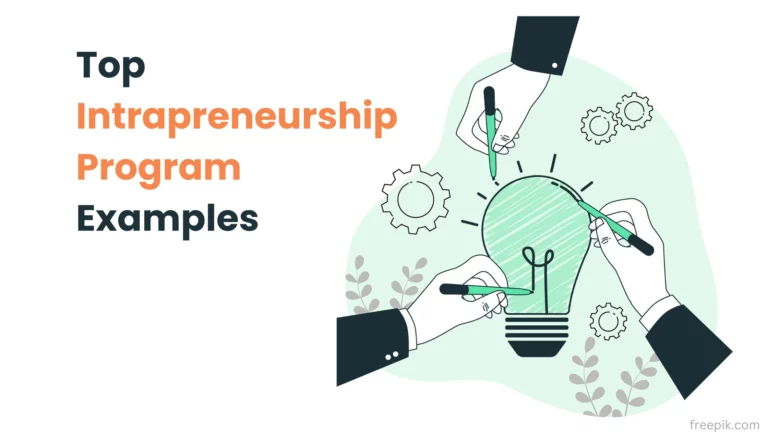What would happen if your smartest employees stopped waiting for permission to innovate and just built the next big thing inside your company?
Now flip that: what if they already did, but you had no system to support them, so they quit and took their genius elsewhere?
And that’s where intrapreneurship programs come in. A structured way to help employees go from “I have an idea…” to “Here’s the product we launched.”
The fun fact is that the term intrapreneur was coined back in 1985 by Gifford Pinchot. Later, it was name-dropped by Steve Jobs in a Newsweek interview the same year.
Still, it took decades for companies to actually build systems around the concept. Only in the last few years have intrapreneurship programs started showing up as core to innovation strategy, not HR side quests.
While digging into examples for our ebook The Power of Employee Innovation, one thing stood out: most successful internal products weren’t just accidents or one-off wins. They were the result of persistent intrapreneurs who kept pushing their ideas forward, even when everyone else had moved on.
But let’s be honest, it’s hard to innovate inside large organizations. Bureaucracy, slow approvals, internal politics, dead-end suggestion boxes… it all adds up.
Over time, employees stop raising their hands. Simply because they don’t see the point.
That’s why your action plan matters.
So today, we’re spotlighting 10 real-world intrapreneurship programs to motivate you and get you going.
#1 GreyB’s AI Challenge: A Grassroots Intrapreneurship Spark
When we say program, our brain automatically visualizes something complex, with a lot of moving parts, a hefty budget, and maintenance.
And not every company has the budget or structure to launch a full-fledged internal startup accelerator. But you don’t have to start there.
Take a page from GreyB.
GreyB’s leadership found an innovative approach in 2024 to go beyong talking about AI adoption. They set an innovation challenge.
After noticing that 80% of employees had already started using AI in their day-to-day work, they rolled out a company-wide AI Challenge to take things up a notch.
The rules? Simple.
Teams of 2–3 people had to identify a real workplace problem and build a Custom GPT to solve it either something that boosts their own productivity, improves team collaboration, or enhances client experience.
The timeline? 2+1 months. The reward? An exotic trip for the top 3 teams.
The only catch? Everyone had to qualify as a team for any pod to win. So no free rides. Everyone had skin in the game.
It wasn’t about big budgets or complicated frameworks. It was about encouraging bottom-up innovation with a little healthy competition and a lot of ownership.
And that’s exactly what makes it a great example of early-stage intrapreneurship done right, no gatekeeping, no waiting for someone to bless the idea. Just people seeing problems, forming teams, and building solutions.
Why it works (and why it’s replicable)?
You don’t need a corporate incubator to kick off intrapreneurship. You need:
- A clear challenge that aligns with real problems.
- Autonomy for teams to define and build.
- A timeline and a bit of pressure.
- And something at stake (yes, the exotic trip helped, but so did the public spotlight).
If you’re a leader wondering where to start, this is it. Don’t overthink it. You could launch something like this with one email and a shared Idea Assist platform.
#2 UQBATE: Telekom’s No-Excuses Innovation Playground
Let’s rewind to 2011.
Johannes Nuenning, then VP of Business Strategy at Deutsche Telekom, was done watching good ideas gather dust in inboxes and ignored decks.
So, he rolled out UQBATE. A lean, no-nonsense intrapreneurship program designed to let employees actually build the ideas they were sitting on.
No committees. No 6-month approval cycles. Only a three-month internal accelerator where employees pitched their concepts, tested them with real users, and got feedback fast.
The result?
- Over 600 employees participated
- 400+ ideas got tested
- 10+ real startups were born, including Zuqi (a service marketplace), MyComoda (a virtual wardrobe app), and eParkomat (a smart parking platform)
These side projects didn’t just stay internal, they spun out into actual ventures.
“We don’t care where you come from. There is no limit regarding the ideas… many reflect the ‘common knowledge’ of a 21st century telecommunications company anyway.”
— Johannes Nuenning
The point?
Most great ideas already exist inside your org. You just need to get out of their way.
Here’s what makes UQBATE insanely replicable even if you’re not a telecom giant:
- Keep the timeline tight. Three months is the sweet spot to stay focused, build momentum, and not burn out.
- Ditch the industry tunnel vision. Ideas didn’t have to serve telecom. That freedom encouraged bold thinking.
- Promote it like a real product launch. UQBATE was marketed internally like a B2C campaign with storytelling, visibility, and executive sponsorship.
600 employees → 400 ideas → 10 startups.
It’s an instant credibility booster when pitching intrapreneurship to your leadership team.
If you’re still thinking intrapreneurship requires a giant budget, think again.
UQBATE shows all it takes is a timeline, some trust, and a culture that says: “You’ve got an idea? Build it.”
Related Read: Top Innovations You Must Start Harnessing Today
#3 Tata InnoVerse: Turning Problems into a Company-Wide Innovation Game
Here’s something clever from one of the oldest business houses in India: the Tata Group.
They launched Tata InnoVerse, a platform that lets anyone across their companies (yes, across all their geographic bases) to spot a problem and open it up for others to solve.
It’s part intrapreneurship, part crowdsourcing, and it’s quietly become one of the most effective idea marketplaces inside a legacy enterprise.
Tata has over 30+ businesses under its belt, everything from steel and salt to AI and automobiles.
So naturally, problems are everywhere.
Instead of burying those in internal emails or waiting on leadership to fix them, InnoVerse lets employees post them as open challenges on a shared internal portal.
Now here’s their USP: anyone across the Tata ecosystem can submit a solution. And if your idea gets selected? It gets piloted, implemented, and you get recognized.
What’s working?
- As of late 2023, 285+ winning ideas and over 60 proof-of-concepts (PoCs) have emerged from the Tata InnoVerse platform.
- It’s not limited to techies or innovation teams, everyone from finance to plant ops gets involved.
- Employees earn “karma points” for participating, giving it a game-like quality that encourages consistent contribution.
- It supports pilots across diverse areas like sustainability, product packaging, robotics, and manufacturing safety.
Here’s why this is a goldmine for intrapreneurship:
- It democratizes who gets to innovate. The welder on the shop floor can contribute just as much as a data scientist at TCS.
- It lets problems come from the frontlines. Because that’s where the friction usually is.
- It gives recognition without requiring people to change jobs or leave their teams.
What you can steal?
You don’t need 100 companies or a giant portal. Just start with:
- One shared innovation platform, Notion or Airtable doc
- 5–6 real, live challenges from different departments
- A system to recognize and act on the top solutions
Bonus: Add a leaderboard or karma point-style tracker. People love friendly competition.
Sometimes, all you need is to let people see a problem and say, “I think I can fix that.”
#4 InGenius: Nestlé’s Crowdsourced Intrapreneurship on Steroids
Nestlé, yep, the food giant behind everything from Nescafé to KitKat quietly built one of the boldest intrapreneurship funnels in recent years.
It’s called InGenius, and it doesn’t just invite a few teams to share ideas.
It mobilizes 65,000 employees across 110 countries to actively solve business problems.
This isn’t just a fun challenge or “innovation week.”
It’s a structured, repeatable sprint system that collects ideas from the global workforce, filters them, and rapidly prototypes the best ones within 3 to 6 months.
Let’s talk scale:
- 65,000+ Nestlé employees involved
- 7,000+ ideas submitted
- 14 MVPs incubated in a single cycle
That kind of volume and speed is rare, even in tech.
What makes it work?
- They solve real problems submitted by internal stakeholders—so solutions are always relevant
- Employees form cross-functional teams and receive resources to develop their ideas
- A jury of internal experts filters ideas using a sharp “go/no-go” matrix
- The best concepts get time, budget, and mentorship to move from PowerPoint to prototype in record time
Here’s what you can borrow:
- Launch a challenge company-wide, but make it focused: ask one high-priority problem, not ten.
- Use a pre-built idea-screening matrix (we can mock one up for you!) to review solutions based on feasibility, ROI, and differentiation.
- Build a 90-day innovation sprint calendar to bring winners to MVP stage.
Even Nestlé’s InGenius proves you don’t need to be a startup to innovate fast, you just need the right structure to unlock the brainpower you already hired.
#5 Spark the Rise: Mahindra’s Big Leap in Open Innovation
Mahindra wanted a movement.
Spark the Rise, launched in 2011, started as a nationwide challenge inviting Indian innovators, but quickly became a shared platform for internal and external intrapreneurs alike.
The Core Idea
Employees and anyone with a bright idea submitted solutions to pressing challenges across mobility, agriculture, sustainability, and social impact.
Each month, winners received seed grants (around ₹500,000–₹3 million total funding) and access to mentorship and network-building support .
The Impact
- 6,000+ submissions in the first year
- 1,473 proposals met impact and feasibility criteria
- 48 grants awarded in the initial funding cycle, totaling ~US $500K.
This wasn’t a one-off campaign, it became a cultural platform where Mahindra employees realized they had permission and potential to make things happen, publicly.
Why It Counts as Intrapreneurship?
- Internal and external blend: It broke down outdated processes, your ideas mattered whether you’re on the factory floor or in corporate strategy.
- Real results: Monthly rounds kept momentum alive and ideas moving.
- Open permission: Employees quickly understood that bold ideas, not job levels, won attention.
What You Can Steal?
- Host a “Launch Week” challenge where teams submit high-impact ideas internally.
- Offer monthly seed grants (even small ones) to keep the ecosystem alive.
- Pair submissions with internal mentorship and feedback loops, not just funding.
Mahindra’s Spark the Rise shows that intrapreneurship isn’t just for startups or internal R&D, it’s a mindset shift.
When people know big ideas don’t need to be from the top, innovation becomes everyone’s game.
#6 Inversation by SAP: When Intrapreneurs Almost Quit but Stayed and Built Instead
This one’s a masterclass in why you need intrapreneurship programs.
Because sometimes, your best internal talent is one email away from leaving and building their idea elsewhere.
Back in 2017, Hemant Rachh, a product specialist at SAP Labs India, and a few colleagues came up with an AI tool that could intelligently qualify and convert sales leads.
It was solid. Real-world problem, actual business value, AI before it was sexy.
They almost quit SAP to build it as a startup.
But SAP had something most companies don’t, a structured, VC-style Innovation and Venture Challenge (InnVent).
So, instead of leaving, they pitched the idea inside.
They got accepted, mentored, and funded through the program.
Eventually, they made it into SAP.iO, SAP’s global startup accelerator.
By 2019, the team was in San Francisco working full-time on Inversation, their startup born inside SAP.
Let that sink in: out of 500 internal ideas, only two were funded. This one made it.
And it happened because SAP gave them a stage, some backing, and a shot at real execution.
What can you take from this?
- Create a clear pitch pathway. A once-a-year internal Shark Tank-style pitch day works wonders.
- Make your evaluation feel real. Give feedback like an investor, not like an HR initiative.
- Let them build while they’re still employed. Not everyone wants to leave—many just want a reason to stay and create.
“It’s exactly like going to a VC for startup funding—but while you keep your corporate job.” – Hemant Rachh
That’s what intrapreneurship looks like when you get it right.
You retain great people and you help them build something game-changing without jumping ship.
Related Read: Business Innovation: The What, Why, How, and Where
#7 Crowdcraft by Airbus: When Intrapreneurship Meets the Crowd
We know corporate innovation gets stuck in boardrooms and internal approval chains, but Mina Bastawros, a mid-level employee at Airbus, wasn’t having it.
He had a bold idea: “Why are we only tapping into internal minds to solve complex engineering problems? What if we open it up to the world?”
So, he pitched something radical for a company the size of Airbus: let’s crowdsource innovation.
That’s how Crowdcraft was born, a crowd-staffing and problem-solving platform that connected internal technical challenges with external solvers.
It’s Airbus’s own private Upwork-for-innovation meets hackathon-on-demand.
The result?
Cost savings and time savings, compared to traditional product development approaches.
Mina didn’t just get a thank-you email.
He was promoted to Strategic Marketing Director and eventually became VP of Creative & Digital Marketing. That’s intrapreneurship with ROI for both the company and the individual.
What can you learn from this?
- Innovation doesn’t always need to stay inside the walls.
Open it up, just a bit, and watch new thinking flood in. - Don’t just run idea contests.
Tie those ideas to real, burning problems teams are struggling with. - Give intrapreneurs visibility and access to leadership.
Mina’s idea only flew (pun intended) because top execs backed it early.
Want to try something like this? Start small:
- Run a “Problem X People” challenge, publish a real internal challenge and invite external thinkers (like academia, partners, alumni) to pitch solutions.
- Assign internal leads to co-pilot the solutions. Let the best idea win a pilot budget or PoC run.
Related Read: How to build an innovation strategy?
#8 BOXLAB @ BASF: Side Idea to Full-Blown Spinout
As a global giant like BASF, with 110,000 employees scattered around the world, they knew hundreds of ideas were just there for the taking.
So BASF built Chemovator, their in-house incubator, back in 2018.
It’s not just a cool name. It’s an actual, functioning venture studio inside the company.
Employees with bold ideas get:
- 2 years to validate and commercialize
- Mentorship, budget, and freedom
- A shot at spinning off their solution as a standalone company (not just a side project buried in IT)
Enter BOXLAB Services GmbH. Their flagship success story.
This one’s so practical it hurts! BOXLAB solves a boring but costly problem of damaged outer packaging.
In regulated industries, damaged boxes = delayed shipments or worse, product waste.
BOXLAB created a digital service to replace those packages within 24 hours. It’s now active in 70+ warehouses across 10 countries.
BOXLAB started inside a corporate maze. Now? It’s an independent, operational business.
What worked here?
- Dedicated venture time. Two full years to test, build, iterate, and own the product.
- Zero fear of spinning out. BASF wants viable ventures to fly solo—they hold a minority stake and benefit from innovation without trying to own it all.
- Support for the messy middle. Not just ideation. They helped teams go from napkin sketch to launch to market traction.
If you want to replicate this, start way smaller. You don’t need a whole venture studio. Try:
- 90-day build sprints with an “intrapreneur-in-residence” model.
- Offer mini-funding + internal expert hours.
- Plan for “off-ramping” if it gains traction, offer the option to spin it out with shared equity.
And that’s the takeaway here: Innovation isn’t always sexy. Sometimes, it’s just a better box.
#9 bCheck at EDF Luminus: When Utilities Go Full Startup Mode
EDF Luminus, a major player in the energy game, knew innovation wasn’t going to come from another management offsite.
They needed to unlock it from within.
So they launched #next, their internal innovation incubator.
The idea? Pull employees out of their daily grind, throw them into a startup-like sandbox, and give them three months to bring an idea to life.
They didn’t just set up a brainstorming room with sticky notes. EDF partnered with Start it @KBC, Belgium’s largest startup accelerator. Teams got:
- A real workspace away from HQ
- Mentorship from startup founders and VCs
- A credit card with seed funding (yep, literally)
That’s how bCheck was born.
Seppe de Sever and his colleague weren’t seasoned startup folks.
Just two employees with a good idea. What if we could detect inefficiencies and failures in HVAC and electrical systems before they happen?
bCheck uses IoT + AI to monitor boilers, heat pumps, and other electric setups in real-time.
It flags breakdown risks before customers face disruptions, making it the preventive maintenance sidekick energy providers didn’t know they needed.
Seppe said it best:
“They gave us a laptop, a credit card with a few thousand euros, and said: go for it.”
No red tape. Just validation, iteration, and execution.
What can you steal from this?
- Remove people from the day-to-day. Innovation doesn’t happen between meetings and daily tasks.
- Set clear timelines. Three months = focused urgency.
- Provide a real budget. Even $2,000 in the right hands can go further than a bloated R&D budget.
- Partner with real startups. External accelerators can inject energy and mindset your internal systems lack.
This wasn’t just a shiny side project. It’s a working product solving a real-world problem. And now EDF has a blueprint to do it again.
Ending Note: The Pattern Is Clear
If you’ve made it this far and read through all the intrapreneurship program examples, you’ve probably noticed the pattern.
The companies may differ.
The industries, the tools, the budgets, even the fancy program names, those all vary. But the core? It’s always the same.
- Give employees space.
- Next, give them time.
- Followed by permission.
- And then? Get out of the way.
When companies, especially the C-suite and innovation leaders like CIOs, intentionally build this kind of culture, it all comes together.
It’s your move now.
Start with a challenge today.



